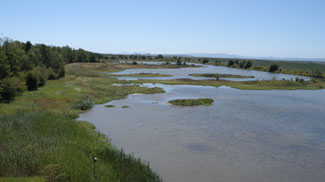What Is a Wetland?

What is a wetland?
Bog, mudflat, quagmire, muskeg, tundra, swamp, fen, marsh, pothole, beach. These are some of the many areas that people recognize as definitely land, but also definitely wet. What do we need to know about a wetland to understand why it is important and how it functions?
Let's start by looking at some common features of any wetland. They are measured and studied by people with different jobs.
How wet is it?
A hydrologist, someone who studies the water cycle, is concerned with the wetness of a specific area. Wetness varies according to how much water falls on it in the form of rain or snow, flows across it from the ocean or upstream, or enters it as runoff from surrounding higher lands. How long an area stays wet and how wet it stays depend on the type of soil or plants, and how steeply the land slopes to the next downstream area. Water disappears down into cracks and holes between rocks or soil particles, is taken up by thirsty plants, or quickly streams off steep cliff faces. However, some water remains on the surface in areas where a subsurface layer of rock or permafrost won't let it continue down into the ground or where it enters an existing pond or stream. Wetlands are areas where water remains pooled on or near the surface and saturates the soils, leaving no airspace for oxygen between the grains.
What adaptations does it take to live there?
To a biologist, wetlands are places where the plants and animals must have adaptations for both terrestrial (on land) and aquatic (in water) life. If the amount of wetness changes, the organism must be able to quickly respond. What would you do to survive if the tide came over your head twice a day? Also, the saturated soil has limited or no oxygen. This means that plants with their roots in the soil and other organisms that live in the soil must have adaptations to these anaerobic or low-oxygen conditions. The plants and tiny animals with these special traits are part of the wetland food web that includes shorebirds.
How do laws define "wetlands"?
Because humans use wetlands for many things, and because humans recognize the importance of wetlands to the overall cycles of nature, there are many laws concerning wetlands. Is the land that you want to build a gravel road across a wetland? Is the land where you saw two rare snowy plovers feeding a wetland? Legal definitions are ones that people use to help answer these questions. These definitions come before the really important questions, like how will people and shorebirds be affected by any changes you make to the area?
There are regulatory agencies that are charged by the Clean Water Act to protect the important functions of wetlands (like providing drinking water). The regulators have a specific legal definition that recognizes hydrological and ecological conditions described above. However, because the water cycle is dynamic and the wetness of an area varies accordingly, determining whether the legal definition is met in a specific area is often very difficult.
 Join In
Join In Archives
Archives